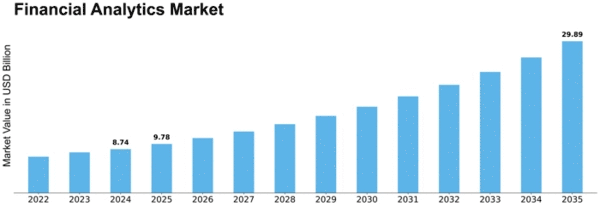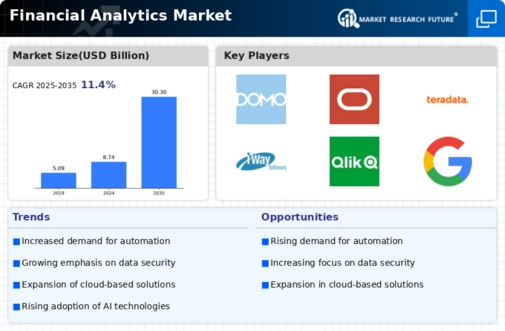-
Executive Summary
-
Market Attractiveness Analysis
- Global Financial Analytics Market, by Component
- Global Financial Analytics Market, by Deployment
- Global Financial Analytics Market, by Organization Size
- Global Financial Analytics Market, by Application
- Global Financial Analytics Market, by Vertical
- Financial Analytics Market, by Region
-
Scope of the Report
-
Market Definition
-
Scope of the Study
-
Market Structure
-
Key Buying Criteria
-
Macro Factor Indicator Analysis
-
Market Research Methodology
-
Research Process
-
Primary Research
-
Secondary Research
-
Market Size Estimation
-
Forecast Model
-
List of Assumptions
-
Market Insights
-
Industry Overview of the Global Financial Analytics Market
-
Introduction
-
Drivers
- Growing need on data driven financial decisions in end-users
- Advancement in Business Intelligence (BI) and business analytics tools
- Growing adoption of predictive analytics
- Drivers Impact Analysis
-
Restraints
- Regulations and standards
- Security and privacy concerns
- Restraints Impact Analysis
-
Opportunities
- Technological advancements such as AI and machine learning
- Growing adoption of predictive analytics
-
Challenges
- Integration of data from data silos
-
Market Factor Analysis
-
Porter’s Five Forces Analysis
- Threat of New Entrants
- Bargaining Power of Suppliers
- Bargaining Power of Buyers
- Threat of Substitutes
- Intensity of Rivalry
-
Value Chain/Supply Chain of the Global Financial Analytics Market
-
Global Financial Analytics Market, by Component
-
Introduction
-
Software
- Market Estimates & Forecast, 2020–2027
- Market Estimates & Forecast, by Region, 2020–2027
-
Services
- Market Estimates & Forecast, 2020–2027
- Market Estimates & Forecast, by Region, 2020–2027
-
Global Financial Analytics Market, by Deployment Type
-
Introduction
-
On-Premise
- Market Estimates & Forecast, 2020–2027
- Market Estimates & Forecast, by Region, 2020–2027
-
Cloud
- Market Estimates & Forecast, 2020–2027
- Market Estimates & Forecast, by Region, 2020–2027
-
Global Financial Analytics Market, by Organization Size
-
Introduction
-
Large Enterprises
- Market Estimates & Forecast, 2020–2027
- Market Estimates & Forecast, by Region, 2020–2027
-
Small and Medium-Sized Enterprises
- Market Estimates & Forecast, 2020–2027
- Market Estimates & Forecast, by Region, 2020–2027
-
Global Financial Analytics Market, by Application
-
Introduction
-
Governance, Risk, and Compliance Management
- Market Estimates & Forecast, 2020–2027
- Market Estimates & Forecast, by Region, 2020–2027
-
Customer Management
- Market Estimates & Forecast, 2020–2027
- Market Estimates & Forecast, by Region, 2020–2027
-
Wealth Management
- Market Estimates & Forecast, 2020–2027
- Market Estimates & Forecast, by Region, 2020–2027
-
Financial Forecasting and Budgeting
- Market Estimates & Forecast, 2020–2027
- Market Estimates & Forecast, by Region, 2020–2027
-
Transaction Monitoring
- Market Estimates & Forecast, 2020–2027
- Market Estimates & Forecast, by Region, 2020–2027
-
Stock Management
- Market Estimates & Forecast, 2020–2027
- Market Estimates & Forecast, by Region, 2020–2027
-
Fraud Detection and Prevention
- Market Estimates & Forecast, 2020–2027
- Market Estimates & Forecast, by Region, 2020–2027
-
Others
- Market Estimates & Forecast, 2020–2027
- Market Estimates & Forecast, by Region, 2020–2027
-
Global Financial Analytics Market, by Vertical
-
Introduction
-
BFSI
- Market Estimates & Forecast, 2020–2027
- Market Estimates & Forecast, by Region, 2020–2027
-
Retail & Ecommerce
- Market Estimates & Forecast, 2020–2027
- Market Estimates & Forecast, by Region, 2020–2027
-
Government and Defense
- Market Estimates & Forecast, 2020–2027
- Market Estimates & Forecast, by Region, 2020–2027
-
Healthcare and Life Sciences
- Market Estimates & Forecast, 2020–2027
- Market Estimates & Forecast, by Region, 2020–2027
-
Energy and Utilities
- Market Estimates & Forecast, 2020–2027
- Market Estimates & Forecast, by Region, 2020–2027
-
Manufacturing and Automotive
- Market Estimates & Forecast, 2020–2027
- Market Estimates & Forecast, by Region, 2020–2027
-
Telecommunication and IT
- Market Estimates & Forecast, 2020–2027
- Market Estimates & Forecast, by Region, 2020–2027
-
Transportation and Logistics
- Market Estimates & Forecast, 2020–2027
- Market Estimates & Forecast, by Region, 2020–2027
-
Others
- Market Estimates & Forecast, 2020–2027
- Market Estimates & Forecast, by Region, 2020–2027
-
Global Financial Analytics Market, by Region
-
Introduction
-
North America
- Market Estimates & Forecast, 2020–2027
- Market Estimates & Forecast, by Component, 2020–2027
- Market Estimates & Forecast, by Deployment Mode, 2020–2027
- Market Estimates & Forecast, by Organization Size, 2020–2027
- Market Estimates & Forecast, by Application, 2020–2027
- Market Estimates & Forecast, by Vertical, 2020–2027
- US
- Canada
- Mexico
-
Europe
- Market Estimates & Forecast, 2020–2027
- Market Estimates & Forecast, by Component, 2020–2027
- Market Estimates & Forecast, by Deployment Mode, 2020–2027
- Market Estimates & Forecast, by Organization Size, 2020–2027
- Market Estimates & Forecast, by Application, 2020–2027
- Market Estimates & Forecast, by Vertical, 2020–2027
- Germany
- France
- UK
- Rest of Europe
-
Asia-Pacific
- Market Estimates & Forecast, 2020–2027
- Market Estimates & Forecast, by Component, 2020–2027
- Market Estimates & Forecast, by Deployment Mode, 2020–2027
- Market Estimates & Forecast, by Organization Size, 2020–2027
- Market Estimates & Forecast, by Application, 2020–2027
- Market Estimates & Forecast, by Vertical, 2020–2027
- China
- India
- Japan
- Rest of Asia-Pacific
-
Rest of the World
- Market Estimates & Forecast, 2020–2027
- Market Estimates & Forecast, by Component, 2020–2027
- Market Estimates & Forecast, by Deployment Mode, 2020–2027
- Market Estimates & Forecast, by Organization Size, 2020–2027
- Market Estimates & Forecast, by Application, 2020–2027
- Market Estimates & Forecast, by Vertical, 2020–2027
- Middle East & Africa
- South America
-
Company Landscape
-
Competitive Overview
-
Competitor Dashboard
-
Major Growth Strategies in the Global Financial Analytics Market
-
Competitive Benchmarking
-
Market Share Analysis
-
XXXX: The leading player in terms of number of developments in the Global Financial Analytics Market
-
Key Developments & Growth Strategies
- Product Launches/Service Deployment
- Mergers & Acquisitions
- Joint Ventures
- Business Expansion
-
Company Profiles
-
Fair Isaac Corporation
- Company Overview
- Product/Business Segment Overview
- Financial Updates
- Key Developments
-
Oracle Corporation
- Company Overview
- Product/Business Segment Overview
- Financial Updates
- Key Developments
-
TIBCO Software Inc.
- Company Overview
- Product/Business Segment Overview
- Financial Updates
- Key Developments
-
IBM Corporation
- Company Overview
- Product/Business Segment Overview
- Financial Updates
- Key Developments
-
Zoho Corporation
- Company Overview
- Product/Business Segment Overview
- Financial Updates
- Key Developments
-
Google
- Company Overview
- Product/Business Segment Overview
- Financial Updates
- Key Developments
-
SAP
- Company Overview
- Product/Business Segment Overview
- Financial Updates
- Key Developments
-
MicroStrategy Incorporated
- Company Overview
- Product/Business Segment Overview
- Financial Updates
- Key Developments
-
TABLEAU SOFTWARE
- Company Overview
- Product/Business Segment Overview
- Financial Updates
- Key Developments
-
Teradata
- Company Overview
- Product/Business Segment Overview
- Financial Updates
- Key Developments
-
SAS Institute Inc.
- Company Overview
- Product/Business Segment Overview
- Financial Updates
- Key Developments
-
Rosslyn Data Technologies
- Company Overview
- Product/Business Segment Overview
- Financial Updates
- Key Developments
-
Deloitte Touche Tohmatsu Limited
- Company Overview
- Product/Business Segment Overview
- Financial Updates
- Key Developments
-
QlikTech International AB
- Company Overview
- Product/Business Segment Overview
- Financial Updates
- Key Developments
-
ALTERYX, INC.
- Company Overview
- Product/Business Segment Overview
- Financial Updates
- Key Developments
-
Conclusion
-
LIST OF TABLES
-
Global Financial Analytics Market, by Region, 2020–2027
-
North America: Financial Analytics Market, by Country, 2020–2027
-
Europe: Financial Analytics Market, by Country, 2020–2027
-
Asia-Pacific: Financial Analytics Market, by Country, 2020–2027
-
Middle East & Africa: Financial Analytics Market, by Country, 2020–2027
-
South America: Financial Analytics Market, by Country, 2020–2027
-
Global Financial Analytics Component Market, by Region, 2020–2027
-
North America: Financial Analytics Component Market, by Country, 2020–2027
-
Europe: Financial Analytics Component Market, by Country, 2020–2027
-
Table10 Asia-Pacific: Financial Analytics Component Market, by Country, 2020–2027
-
Table11 Middle East & Africa: Financial Analytics Component Market, by Country, 2020–2027
-
Table12 South America: Financial Analytics Component Market, by Country, 2020–2027
-
Table13 Global Financial Analytics Deployment Mode Market, by Region, 2020–2027
-
Table14 North America: Financial Analytics Deployment Mode Market, by Country, 2020–2027
-
Table15 Europe: Financial Analytics Deployment Mode Market, by Country, 2020–2027
-
Table16 Asia-Pacific: Financial Analytics Deployment Mode Market, by Country, 2020–2027
-
Table17 Middle East & Africa: Financial Analytics Deployment Mode Market, by Country, 2020–2027
-
Table18 South America: Financial Analytics Deployment Mode Market, by Country, 2020–2027
-
Table19 Global Financial Analytics Vertical Market, by Region, 2020–2027
-
Table20 North America: Financial Analytics Vertical Market, by Country, 2020–2027
-
Table21 Europe: Financial Analytics Vertical Market, by Country, 2020–2027
-
Table22 Asia-Pacific: Financial Analytics Vertical Market, by Country, 2020–2027
-
Table23 Middle East & Africa: Financial Analytics Vertical Market, by Country, 2020–2027
-
Table24 South America: Financial Analytics Vertical Market, by Country, 2020–2027
-
Table25 Global Financial Analytics Component Market, by Region, 2020–2027
-
Table26 Global Financial Analytics Deployment Type Market, by Region, 2020–2027
-
Table27 Global Financial Analytics Vertical Market, by Region, 2020–2027
-
Table28 North America: Financial Analytics Market, by Country
-
Table29 North America: Financial Analytics Market, by Component
-
Table30 North America: Financial Analytics Market, by Deployment Type
-
Table31 North America: Financial Analytics Market, by Vertical
-
Table32 Europe: Financial Analytics Market, by Country
-
Table33 Europe: Financial Analytics Market, by Component
-
Table34 Europe: Financial Analytics Market, by Deployment Type
-
Europe: Financial Analytics Market, by Vertical
-
Table36 Asia-Pacific: Financial Analytics Market, by Country
-
Table37 Asia-Pacific: Financial Analytics Market, by Component
-
Table38 Asia-Pacific: Financial Analytics Market, by Deployment Type
-
Asia-Pacific: Financial Analytics Market, by Vertical
-
Table40 Middle East & Africa: Financial Analytics Market, by Country
-
Table41 Middle East & Africa: Financial Analytics Market, by Component
-
Table42 Middle East & Africa: Financial Analytics Market, by Deployment Type
-
Table43 Middle East & Africa: Financial Analytics Market, by Vertical
-
Table44 South America: Financial Analytics Market, by Country
-
Table45 South America: Financial Analytics Market, by Component
-
Table46 South America: Financial Analytics Market, by Deployment Type
-
Table47 South America: Financial Analytics Market, by Vertical
-
LIST OF FIGURES
-
Global Financial Analytics Market Segmentation
-
Forecast Methodology
-
Porter’s Five Forces Analysis of the Global Financial Analytics Market
-
Value Chain of the Global Financial Analytics Market
-
Share of the Global Financial Analytics Market, by Country, 2020 (in %)
-
Global Financial Analytics Market, 2020–2027
-
Sub-Segments of Component
-
Global Financial Analytics Market Size, by Component, 2020
-
Share of the Global Financial Analytics Market, by Component, 2020–2027
-
Global Financial Analytics Market Size, by Deployment Type, 2020
-
Share of the Global Financial Analytics Market, by Deployment Type, 2020–2027
-
Global Financial Analytics Market Size, by Vertical, 2020–2027
-
Share of Global Financial Analytics Market, by Vertical, 2020–2027


















Leave a Comment